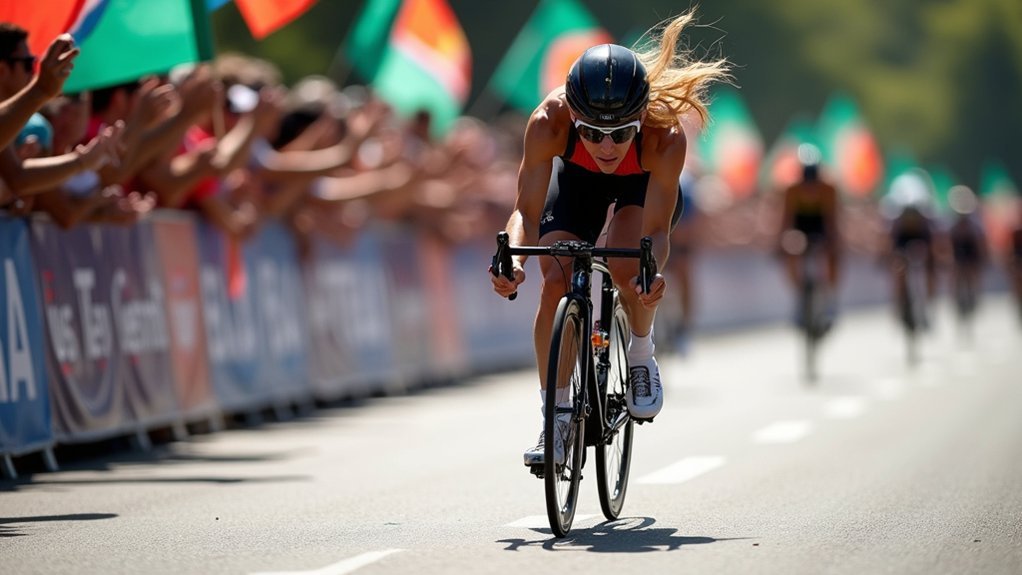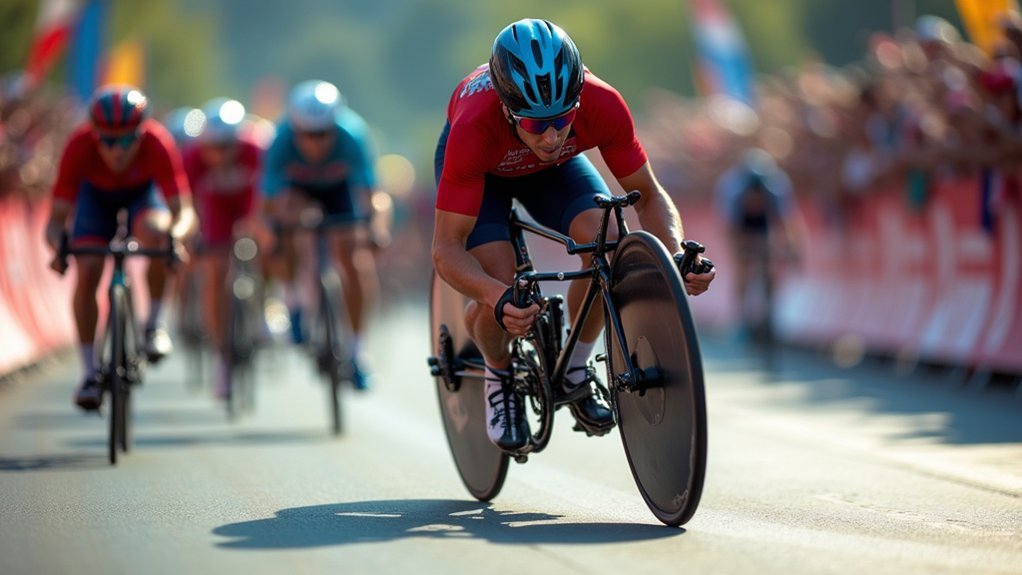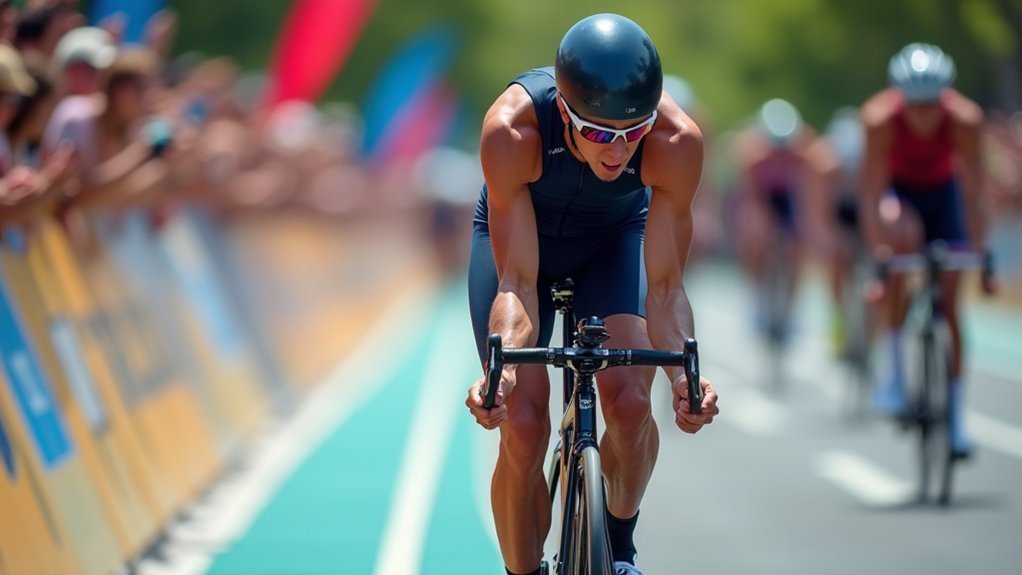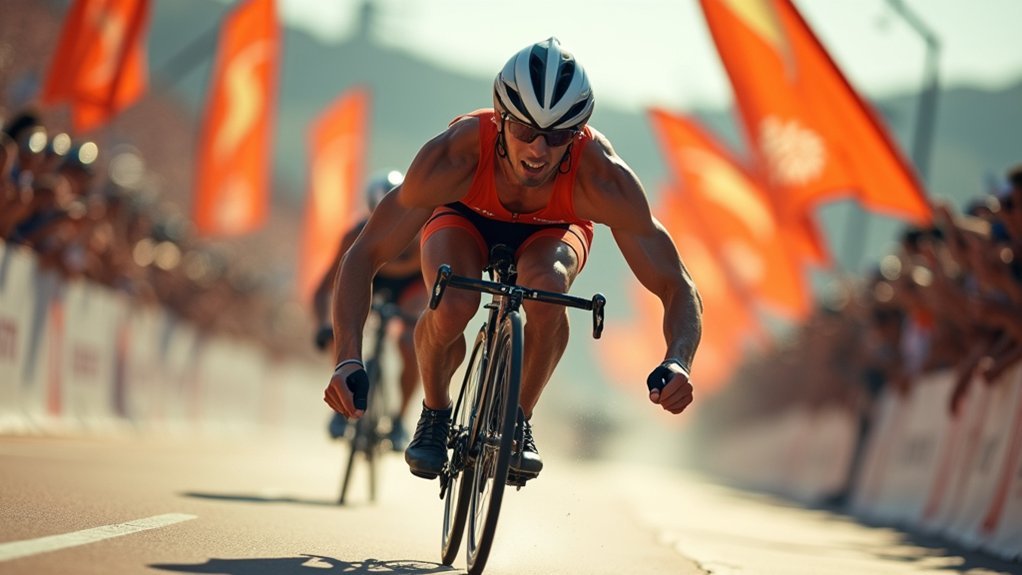Dominating hand-cycle racing requires both physical preparation and tactical knowledge. Build explosive power through resistance training targeting propulsion muscles, and master energy conservation by drafting 2-3 feet behind competitors to save up to 30% energy. Customize your handcycle with lightweight components, preview race courses to identify best racing lines, and develop a solid nutrition strategy with 30-60g carbohydrates per hour during races. The difference between victory and defeat often lies in these critical but overlooked details.
How to Dominate Hand-Cycle Racing Events

While many hand-cyclists focus solely on logging miles, dominating races requires a more strategic approach.
To excel on race day, prioritize quality training time over distance by gradually increasing resistance to build strength efficiently on your handcycle.
Efficiency trumps mileage—build race-ready power through progressive resistance training rather than endless hours on your handcycle.
Familiarize yourself with different race formats and develop specific tactics like drafting for mass-start events and pacing for time trials.
Practice gear shifting and handling techniques on flat terrain before tackling more complex scenarios.
Always preview the race course to identify ideal lines and potential hazards—this reconnaissance is essential for developing an effective race strategy.
Finally, don’t overlook nutrition; fuel properly with carbohydrates before competing and plan your mid-race fueling strategy.
Proper preparation of your adaptive equipment and body will set you up for peak performance when it matters most.
Building Upper Body Strength for Explosive Power
To build the explosive power needed for hand-cycle racing domination, you’ll need a strategic resistance training program that targets key propulsion muscles with exercises like bench presses and medicine ball slams.
Your training should include interval sprinting routines that mimic race conditions, pushing your upper body to generate quick bursts of speed while maintaining technique.
Balancing core and shoulder strength creates the stable power transfer system essential for maximizing every stroke, preventing energy waste, and sustaining your competitive edge throughout longer races.
Strategic Resistance Training
Since handcycling demands exceptional upper body strength, your resistance training routine must strategically target the muscle groups that power each stroke. Incorporate bench presses, pull-ups, and dumbbell rows 2-3 times weekly to develop the explosive power needed for sprints and climbs.
Progressive overload is essential—gradually increase weights to build muscle endurance that sustains performance throughout races. Resistance bands effectively mimic handcycling’s pulling motion, improving functional strength through seated rows and chest presses.
Don’t neglect your core; planks and medicine ball rotations stabilize your torso, maximizing force transfer from upper body to handcycle.
Track your progress meticulously by recording maximum weights lifted and repetitions completed. This data-driven approach guarantees you’re consistently challenging your muscles for peak power development and race-day dominance.
Interval Sprinting Routines
The three most effective interval sprint routines will transform your handcycling performance virtually overnight. Alternate between 30-second maximum-effort bursts and 90-second recovery periods, maintaining high resistance during sprints to develop explosive power.
Include 2-3 weekly interval sessions, gradually intensifying as your upper body strength improves. Complement these workouts with targeted exercises for shoulders, chest, and core.
| Sprint Type | Work Period | Recovery | Sets | Benefits |
|---|---|---|---|---|
| Power Burst | 30 sec | 2 min | 6-8 | Maximum force output |
| Endurance | 1 min | 1 min | 5-6 | Sustained power |
| Pyramid | 15/30/45/30/15 sec | 1 min | 4 | Variable power control |
Track your sprint distances to measure progress and adjust your training accordingly. This combination will build the explosive power necessary for race-winning performance.
Core-Shoulder Power Balance
Mastering the delicate balance between core stability and shoulder power forms the foundation of elite handcycling performance. Your core strength acts as the anchor that stabilizes your upper body, allowing for efficient power transfer through your stroke mechanics. Without this stability, even the strongest shoulders can’t deliver their full potential.
Incorporate at least two weekly strength sessions focusing on compound movements that engage both muscle groups simultaneously. Try planks and medicine ball throws to enhance your core strength, while adding shoulder presses and rows to build essential shoulder strength for explosive acceleration.
Don’t overlook plyometric exercises like medicine ball slams—they’re game-changers for developing the explosive upper body power you’ll need during races.
This balanced approach guarantees you’ll maintain proper form while generating maximum force through every phase of your handcycle stroke.
Mastering Energy Conservation Through Drafting Techniques
Drafting behind other handcyclists isn’t just advantageous—it’s vital for conserving up to 30% of your energy during races.
Position yourself 2-3 feet behind the lead cyclist’s rear wheel to maximize aerodynamic benefits while maintaining safety and awareness of their movements.
In pack formations, strategically alternate the lead position with teammates, using clear communication to coordinate pace changes and save essential energy for powerful finishing sprints.
Drafting Fundamentals
While many handcyclists focus on power output and equipment enhancement, your strategic positioning behind competitors can dramatically reduce your energy expenditure during races. By drafting within 2-3 feet of the rider ahead, you’ll slash wind resistance by up to 30%, conserving valuable energy for critical race moments.
Maintain a steady pace while closely monitoring your front rider’s movements to prevent collisions. Your positioning must be precise—not too close to risk contact, yet near enough to maximize aerodynamic benefits.
Effective communication with teammates enables coordinated position shifts, distributing energy demands across your team.
Dedicate training time specifically to drafting practice. This develops the control and confidence needed to maintain ideal positioning throughout long races, transforming energy conservation into a competitive advantage that can determine your success.
Pack Position Strategy
Three vital positions exist within a handcycle peloton, each offering distinct advantages during different race phases. Your strategic placement determines both energy conservation and competitive advantage.
By mastering drafting techniques, you’ll save that essential 30% energy while maintaining ideal pack position.
- Front position offers control but requires maximum power output—ideal for breakaways or final sprints.
- Middle position provides maximum drafting benefit (30% energy savings) while allowing you to observe race dynamics.
- Rear position lets you conserve energy but risks getting dropped during pace changes.
- Diagonal positioning helps when crosswinds appear—offset slightly from the rider ahead.
- Always verify your safety flag remains visible to others while maintaining the 1-2 bike length drafting distance.
Remember to rotate positions with teammates to share workload while maintaining collective speed advantage.
Strategic Race Positioning for Competitive Advantage

Smart positioning during hand-cycle races can make the difference between victory and defeat. By strategically placing yourself in the pack, you’ll conserve energy through drafting while maintaining higher speeds. Study the course layout before each race to anticipate terrain changes and position yourself advantageously.
| Position | Advantage | When to Use |
|---|---|---|
| Front | Control pace, see obstacles | Technical sections, final sprint |
| Middle | Energy conservation | Long flat sections |
| Rear | Recovery | Only temporarily when needed |
Stay near the front during criteriums to avoid getting trapped behind slower riders in corners. Time your attacks wisely—launch after turns or during climbs when competitors are fatigued. Regular practice of positioning techniques will enhance your ability to react quickly and maintain your best race position when it matters most.
Perfecting Your Cornering Skills at High Speeds
Mastering corners at high speeds separates elite hand-cyclists from the pack, often determining race outcomes more than raw power alone.
Your cornering technique directly impacts your race performance, so focus on refining these critical skills:
Perfect your cornering technique to elevate your racing performance – it’s the difference maker when seconds count.
- Shift your body weight toward the inside of each turn to maintain stability while cornering at high speeds.
- Downshift before entering corners to maximize control and enable quick acceleration as you exit.
- Visualize your racing line, identifying precise entry, apex, and exit points for best flow.
- Keep a consistent cadence through turns and avoid sudden braking that could cause dangerous skids.
- Practice cornering drills that simulate race conditions, gradually increasing speed to build confidence.
Interval Training Methods to Boost Race Performance

While conquering corners gives you tactical advantages in races, your raw power and stamina form the foundation of winning performances. Incorporate 1-2 HIIT sessions weekly, alternating between 30-60 second maximum efforts and recovery periods to dramatically improve your anaerobic capacity.
Structure your program with both uphill sprints and flat speed intervals, aiming for 5-10 hill repeats while maintaining strong cadence. Monitor your heart rate during intense efforts, targeting 85-95% of your maximum to optimize training benefits.
Don’t neglect endurance intervals—sustained 5-10 minute efforts at 75-85% of max heart rate build your aerobic foundation, enabling you to maintain higher speeds throughout longer races.
As your fitness improves, gradually increase both intensity and duration of work intervals to enhance power output and race-day performance.
Nutrition Strategies for Optimal Endurance Racing
Your pre-race fueling plan should include a carbohydrate-rich breakfast at least three hours before racing or an energy bar 60-90 minutes prior for early starts.
During competition, keep easily digestible nutrition like gels and chews accessible to maintain energy levels without risking gastrointestinal discomfort.
After crossing the finish line, consume a combination of carbohydrates and protein within 30 minutes to optimize recovery and prepare your body for future training sessions.
Pre-Race Fueling Plan
Three key elements form the foundation of effective pre-race nutrition for hand-cycle racing: timing, composition, and quantity.
Your pre-race fueling plan directly impacts your energy levels and overall performance during competition.
- Consume a balanced breakfast with carbohydrates like oatmeal or whole-grain toast at least three hours before your race.
- Opt for lighter options such as energy bars or bananas 60-90 minutes before early morning starts.
- Prepare mid-race nutrition delivering 30-60 grams of carbohydrates per hour.
- Stay well-hydrated days before racing, drinking 16-20 ounces of fluid 2-3 hours pre-race.
- Avoid heavy meals close to race time, focusing instead on easily digestible carbohydrates.
Properly timing your nutrition guarantees you’ll have maximum energy without digestive discomfort when you need performance most.
Recovery Nutrition Essentials
Effective recovery begins the moment your race ends, setting the stage for your next training session or competition.
Within 30 minutes post-race, consume 1.0-1.5g of carbohydrates per kilogram of your body weight to replenish glycogen stores. Include a recovery shake with a 3:1 or 4:1 carb-to-protein ratio to accelerate muscle repair.
Hydration is critical—drink 16-24 ounces of fluid for every pound lost during your race, ensuring you include electrolytes to restore balance.
Don’t overlook antioxidants from fruits and vegetables to combat race-induced inflammation.
Complete your post-race nutrition strategy by eating a balanced meal within two hours of finishing. This timing maximizes recovery benefits, combining carbohydrates, protein, and healthy fats to prepare your body for your next hand-cycling challenge.
Mental Preparation Tactics for Race Day Success
While physical training forms the foundation of hand-cycle racing success, mental preparation often separates champions from competitors on race day. Building mental fitness requires intentional practice just like your physical training regimen.
Develop a consistent pre-race routine that calms your nerves and centers your focus before the starting line.
Establish your personal starting line ritual to quiet the mind and sharpen your competitive edge.
- Visualize yourself successfully maneuvering the course, feeling strong through each turn and climb
- Practice deep breathing or meditation techniques to manage pre-race anxiety
- Set specific, achievable goals for each race to maintain motivation
- Use positive self-talk to overcome challenges during tough race segments
- Review previous performances to identify strengths and build on successful strategies
These mental tactics will help you maintain composure under pressure and access your peak performance when it matters most.
Customizing Your Handcycle for Maximum Efficiency
Fine-tuning your handcycle to match your unique physical capabilities and racing environment can dramatically improve your performance advantage on the course. Start by adjusting your seat position for ideal power transfer and comfort during long races. Then focus on customizing gear ratios based on your strength profile and typical race terrain.
| Modification | Performance Benefit |
|---|---|
| Lightweight carbon fiber components | Reduces overall weight for better acceleration |
| Aerodynamic fairings | Decreases wind resistance at high speeds |
| Customized seat position | Enhances power transfer and reduces fatigue |
| Optimized tire pressure | Improves traction and rolling efficiency |
Don’t overlook the significant gains from lightweight materials like carbon fiber wheels and handlebars. These modifications, combined with aerodynamic accessories, will maximize efficiency while reducing energy expenditure—giving you the competitive edge you need.
Developing Effective Paceline Communication
Nearly every championship-winning handcyclist knows that mastering paceline communication can mean the difference between victory and defeat in close races.
Establishing clear verbal signals for slowing, accelerating, or position changes guarantees your team moves as one cohesive unit on race day.
Effective paceline communication transforms individual handcyclists into a synchronized racing machine, maximizing every advantage in championship competition.
- Combine verbal signals with hand gestures to guarantee messages are received even at high speeds when voices may be difficult to hear
- Establish and maintain consistent rhythm and cadence within your paceline to conserve energy
- Keep your eyes forward to anticipate movements from riders ahead of you
- Practice communication techniques regularly in controlled environments before competitions
- Build trust with teammates through clear, concise messages that everyone understands immediately
Weather Adaptation Skills for Various Racing Conditions
Successful handcyclists understand that adapting to diverse weather conditions can transform challenging race environments into competitive advantages. Your weather adaptation skills begin with strategic layering—adding or removing clothing as needed to regulate body temperature while maintaining performance efficiency.
Don’t underestimate hydration during cold weather racing. You’ll still lose fluids even when you’re not noticeably sweating, so drink regularly before and throughout your race.
Practice handling techniques for wet leaves or icy patches by simulating slippery conditions in controlled environments.
Remember to adjust your tire pressure according to temperature fluctuations, as cold weather increases your flat tire risk. Check pressure before every race day.
Finally, monitor weather forecasts religiously to prepare appropriate gear options for rain, wind, or temperature extremes, ensuring you’re never caught unprepared when conditions change.
Frequently Asked Questions
How to Steer a Handcycle?
You’ll steer your handcycle using either fork-steer handlebars or lean-to-steer body movements. Keep your motions smooth and controlled, maintain an upright posture, and practice regularly on flat terrain to build confidence and skill.
How Can I Get Better at Cycling Races?
Focus on high-intensity workouts rather than just distance. Practice race-specific skills like cornering and drafting. Master your gear shifting, stay safe during outdoor training, and scout race courses beforehand to identify ideal lines.
How Fast Can a Handcycle Go?
You’ll typically reach 18-20 mph on a handcycle during races, with top speeds up to 25 mph. Your aerodynamic recumbent model, strength, technique, and conditions like terrain and weather will affect your speed capabilities.
How to Win a Bicycle Race?
To win a bicycle race, you’ll need strategic pacing, efficient drafting, and perfect timing for attacks. Study the course, monitor competitors’ weaknesses, maintain ideal cadence, and save energy for decisive moments like climbs and sprints.
In Summary
Dominating hand-cycle racing isn’t just about raw power—it’s about mastering technique, strategy, and mental preparation. You’ve now got the tools to build strength, draft effectively, position strategically, and corner confidently. Remember that equipment customization and weather adaptation give you competitive edges. When you combine physical training with tactical awareness and clear communication, you’ll transform from competitor to champion. Now get out there and dominate your next race!





Leave a Reply